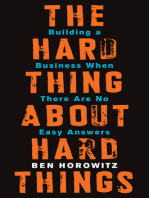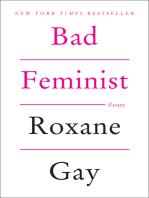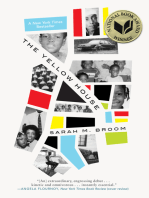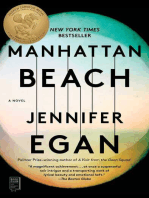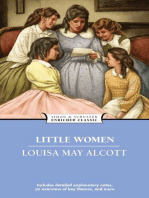0 ratings0% found this document useful (0 votes)
24 viewsBai 6 Reading
Bai 6 Reading
Uploaded by
Phương Trần Thị ThanhCopyright:
© All Rights Reserved
Available Formats
Download as PDF or read online from Scribd
Bai 6 Reading
Bai 6 Reading
Uploaded by
Phương Trần Thị Thanh0 ratings0% found this document useful (0 votes)
24 views20 pagesOriginal Title
BAI 6 READING
Copyright
© © All Rights Reserved
Available Formats
PDF or read online from Scribd
Share this document
Did you find this document useful?
Is this content inappropriate?
Copyright:
© All Rights Reserved
Available Formats
Download as PDF or read online from Scribd
Download as pdf
0 ratings0% found this document useful (0 votes)
24 views20 pagesBai 6 Reading
Bai 6 Reading
Uploaded by
Phương Trần Thị ThanhCopyright:
© All Rights Reserved
Available Formats
Download as PDF or read online from Scribd
Download as pdf
You are on page 1of 20
Once the preparatory written work is done, they can all go
around asking each other their own questions. They can
present their results orally or in writing. Again, this is a
structured activity but it involves communication and doing
something with the information they’re told. It can also
involve a little bit of arithmetic and the setting up of tables.
Questions and activities
Look back at the exercise at the bottom of page 38. It uses
cards which are all about food. Can you think of more topics
you could make cards for?
Look at your textbook and list the activities from one lesson
which are designed to practise oral language. Do you like
them? Do you think they will be useful for your class? If
you're not happy with them, how would you make them more
suitable for your class?
Either on your own or with a colleague, add some more free
oral activities to the ones given in this chapter. They may be
things you've done in class or read about elsewhere, or they
may be activities which you've thought out yourself.
we
oo
References
Howe, D H 1985 English Today! ~ a 6-Level course for children,
Oxford University Press
Scott, W 1983 Are You Listening? Hong Kong Edition, Oxford
University Press
Worall, A and Abbs, B 1988 Longman Picture Wordbook
Activity Book, Longman
Wright, A 1976 Visual Materials for the Language Teacher
Longman
Reading
Just as listening is the main source of language when pupils
start to learn a language, print is the second main source. As
pupils become better and better in the foreign language, the
printed word becomes the main source of expanding and
strengthening the language. Reading is also the language skill
which is easiest to keep up ~ many of us can still read in a
foreign language that we used to be able to speak as well.
Books open up other worlds to youhg children, and making
reading an enjoyable activity is a very important part of the
language learning experience.
Approaches to reading
Many five to ten year olds are in the process of learning to read
in their own language. Whether or not they have mastered the
skill in their own language, and whether or not their own
language is written in the Roman alphabet, will have an effect
on the initial stages of teaching reading in English.
example, a German child of nine will already be f
most of the techniques of reading - with word di
sentence links, paragraphs, how letters relate to sounds, how
the illustrations help him or her understand what is going on. A
Japanese child of nine will also be aware of much the same
things, but he or she may not be very familiar with the Roman
alphabet or relate sounds to individual Roman letters. Clearly,
children whose mother tongue is not based on the Roman script
have more stages to go through when they are learning to read
in English.
1
There are a number of different ways to approach the
introduction of reading in a foreign language.
1 Phonics
Basically, we teach
the pupils the letters of the alphabet, and the combination of
letters, phonically — as they are actually pronounced ~ so that
the letter a is pronounced /z/, the letter b is pronounced /b/, ¢ is
pronounced /k/, ph is pronounced /f/ and so on. It is best to start
off with three or four letters that can make up a number of
words, like c a n t. You can then show pupils how to pronounce
/wen/,/ket/,/kent/and/ten/.
Although phonics can become very complicated as all the
pronunciation rules are introduced, it can be a very useful way
into reading for those learners who are not familiar with the
Roman alphabet or who do not have a one to one relationship
between letters and sounds in their own written language. It is
not to be recommended as the main way into reading for those
pupils who are already reading in their own language using the
Roman alphabet, and it should not be taught to pupils who are
learning to read using phonics in their own language — this
could lead to great confusion in pronunciation.
2 Look and say
| This approach is based on words and phrases, and makes a lt
of use of flashcards - words written on cards like thi
a book
my book the blackboard
It is usual to start by teaching
already familiar to the children.
repeat the word. This happens several times with each word.
The introduction of the words only takes a short time, and goes
quite quickly, so the teacher may spend five minutes of a thirty
minute lesson on four new words. There are a lot of word
recognition games which can be done at this stage - matching
words and pictures, pointing to the object on the card, guessing
which card Teddy has picked out of the hat — and so this
approach encourages recognition of a range of words and
phrases before ‘reading’ a text.
3 Whole sentence reading
Here
‘is often means
a story which the children read for the first time themselves
after the whole text is familiar to them. The words are not
51
presented in isolation, but as whole phrases or sentences. Since _
we will look at this approach in more det low.
4 Language experience approach
This approach to reading is based on the child’s spoken
language. The teacher writes down a sentence for the child to
read which is based on what the child has said. For example:
This is me.
My sister is nine. She is in class 3F.
This is a posteard from my uncle in Milan.
Again, since we think that this is a good, pupil-centred
approach to reading, we will go into it in more detail below.
Clearly, if there was one correct method for teaching all
children to read, then only one method would exist. We favour
an approach which concentrates on meaning from the beginning.
However, if your pupils have a mother tongue which is not
based on the Roman script, you will probably find that you will
have to spend quite some time teaching phonics and word
recognition first.
No matter which approach to reading you take as your basic
approach, you should remember that all these approaches are a
way in to reading and are not an end in themselves. You will
probably want to make use of all the methods described at some
stage in the process of learning to read.
== ti ero years olds are likely to take longer to learn to
read in a foreign language than eight to ten year olds. Some
children starting school are not familiar with books or what
they are used for. They have to go through the process of
doing reading-like activities first — ‘reading’ from left to right,
turning the pages at the ri
the same pages again, etc.
© If your pupils have not learnt to read in their own language,
many will not yet have understood what a word is, nor what
the connection is between the spoken and the written word.
is an
Reader
Sentence structure, paragraphing, grammar — none of this
means anything to most pupils at this stage.
Decoding reading ~ making sense of what we see on the page
~ is a very involved process, and adults make use of all sorts
of clues on the written page — punctuation, paragraphing, use
of special words, references to things which have happened,
hints as to what can happen. What five to seven year olds
have instead is often a visual clue and this clue is vital to
meaning.
Take, for example, Belinda’s Story by Margaret Iggulden, a
story written for four to seven year olds. The story is about an
elephant called Belinda who goes around looking at animals of
different colours. The text of the last three pages of the story 1s:
I'm an elephant and I’m grey.
That’s an elephant. It’s super.
I'm an elephant and I’m super.
Without the drawings, you don’t know that the elephant is
unhappy about being grey. Here are the last three pages taken
from the book, with the accompanying illustrations:
— |
7 elephont
One of the conclusions to be drawn from this is that the
illustrations in a book for young children matter almost as
much as the words themselves.
inglish. This
means that you can spend much less time teaching the
mechanics of reading, and concentrate more on the content.
Children whose mother tongue is not based on the Roman
alphabet will still have to spend more time on the mechanics of
reading, but they know what reading is about, and this speeds
up the process.
Starting off
Let us take as our example a class of six year olds who have
English for three short lessons a week. Let’s look at four
possible starting points.
1 Reading a story from a book
Look back at what we said in Chapter 3 about reading stories.
Some of the stories which you read aloud will become the stories
that your pupils read. Let’s take Belinda’s Story as our
example. The whole text of the story is as follows:
That's a bird. It’s green.
That’s a butterfly. It’s red.
‘That's a fish. It’s blue.
That's a crab. It’s yellow.
That's a cat. It’s white.
I'm an elephant and I’m grey.
That’s an elephant. It’s super.
Tm an elephant and I'm super.
a)
b)
)
qd
e)
8)
Look back at what we said on page 28 about
creating a routine for story reading. This is not a big book,
so you will have to read with quite a small group.
Read the book so that all the pupils can see it, and point to
the words as you say them. This is important if your pupils
are to understand the connection between the spoken and
the written word. It also helps these beginners to
understand what a word is. Some children may think that
‘butterfly’ is two words. Read at just under normal speed
the first time, keeping your intonation correct.
Let pupils point and ask questions if they want to, but not
so much that it interrupts the flow of the story.
Encourage the pupils to talk about the story. Ask them
questions in their own language, like, ‘Why was Belinda
unhappy?’ ‘Were the other animals unhappy?’ ‘Which
animal did you like best?’ ‘Do you think Belinda is super?”
Leave the book in the book corner. Tell the group they can
read it on their own if they want to.
The next week, read the story again. Let them give you
some of the words.
Teacher: ‘That's a...”
Pupils: ‘Cat.’
Teacher: ‘It’s ..... :
Pupils: ‘White’.
Teacher: ‘Yes. That’s a cat. It’s white.’
Give all the pupils their own copy if possible and tell them
to follow it while you read to them. Encourage them to point
to the words as you read, but don’t slow down.
55
h) If you see pupils pointing to the wrong words, sit with them
and point with them.
i) Let them read the book silently for themselves.
j) Tell them they can read the book whenever they have time,
Go back to it from time to time and read it with the whole
class. Pupils don't usually get tired of good stories, and this
is a good, simple story.
2 Reading a class story
Instead of reading from a book, you might want to use a class
story as your starting point for reading. This has the advantage
that you can photocopy freely, making sure that everyone has a
copy, and the pupils can colour their own copies. There’s also
the point that shared stories are always a good starting point
simply because they are shared.
In a class where Teddy is used, build up a short story about
Teddy using the story-telling techniques already described in
Chapter 3. If you have already read the story about Belinda,
you and the pupils could make up a story about Teddy who
doesn’t like being brown/white/beige or whatever colour he is.
This allows you to keep the same structure, but bring in more
colours and animals:
That’s a bird. It’s orange. That’s a fly. It’s green. That’s a
frog. It’s green too. That’s a zebra. It’s black and white. I'm
Teddy and P'm beige. He’s Teddy and we love him. He’s
great. 'm Teddy and I'm great.
When you make the book ask pupils to help you with the
illustrations if they can. These ones were done by nine year olds
at Mosstodloch Primary Schoo! in Morayshire.
Your story can now be treated in the same way as above, but
you can give the pupils their copies quite quickly. Remember
that Teddy’s story must look like a book with pages to tun and
pictures to look at.
3 Reading texts based on the child’s language
This approach has proved effective with beginners in both age
groups. The idea is that each individual pupil has his or her
own written text which says what he or she wants it to say, and
is used for both mother tongue and foreign language learning.
When working in the foreign language, it is important that the
teacher does not set the pupil a task which he or she does not
have the words for in that language. For example, there’s no
point in pupils bringing in a picture of the place where they
live, if they have no words to talk about it.
This type of reading is often based on a picture, but can be
about something which has happened, or just about how the
pupil is feeling today. It is easiest to start off with a picture.
a) Ask the child to tell you about the picture.
b) Ifhe or she gets stuck, ask either/or questions. ‘Is she tall
or small?”
©) If this still doesn’t work, let the child tell you what he or
she wants to say in his or her own language. If this
translates into something familiar, talk about it, make sure
the child understands. Do not write words which are new or
unfamiliar.
d) Write a sentence in the child’s book based on what the child
has told you. It can be very simple. ‘This is me at home.’
e) Let the child see you writing the sentence, and say the
words as you write them.
f) The child repeats the sentence after you, pointing to the
words as he or she says them.
g) This is now that pupil’s reading task, which he or she can
read aloud to you.
h) It shouldn’t take more than a couple of minutes to do this ~
_ you have a lot of pupils in your class.
i) This sentence can gradually be built on. ‘This is me at
home. It’s my bedroom. It’s blue. It’s nice. I have fish in my
bedroom,”
j) As the child’s vocabulary increases, you can gradually build
up stories.
57
‘The same technique can be used for making up group/class
reading books. This technique of writing down what your pupils
say or the stories they tell you helps the five to seven year olds
to see that print is a means of communication, and that there is
a relationship between the amount of talking that is done and
the amount of writing on the page. For both age groups, it is
important that the pupils see themselves as writers with
something to say.
4 Reading familiar nursery rhymes or songs
Most children learn nursery rhymes in their mother tongue and
in English without having a complete understanding of what
they're saying. Some nursery rhymes are produced as
books, so the children can ‘read’ what they already know off by
heart. While you might say that this isn’t real reading, the
pupil can behave like a reader, and it helps to build up
confidence. As we have said before, there is also a very narrow
dividing line between knowing something off by heart and
actually reading the words.
Reading aloud
Let us now move on to look at various reading techniques
When we went to school, most of the reading done in class was
reading aloud. Reading aloud is not the same as reading
silently. It is a separate skill and not one which most people
have that much use for outside the classroom. But it can be
useful, especially with beginners in a language.
Traditionally, reading aloud is often thought of as reading round
the class one by one, and although many children seem to enjoy
it, this type of reading aloud is not to be recommended:
© It gives little pleasure and is of little interest to the listeners.
© It encourages stumbling and mistakes in tone, emphasis and
expression.
© It may be harmful to the silent reading techniques of the
other pupils.
© It is a very inefficient way to use your lesson time.
However, reading aloud is a useful technique when used
slightly differently:
Reading aloud to the teacher should be done individually or
in small groups. The reader then has the teacher’s full
attention. Reading aloud from a book lets the teacher ask
about meaning, what the pupils think of the book, how they
are getting on with it, as well as smooth out any language
difficulties which arise. High priority should be given to this
kind of reading aloud, especially at the beginner stage for all
ages. By the time pupils progress to level two, this kind of
reading is not so necessary.
The teacher can use it as a means of training and checking
rhythm and pronunciation. The teacher can read a sentence
or a phrase and the class or parts of the class can read in
chorus after. This is particularly useful if the text is a
dialogue, but should only be done for a very short time.
Choral reading can easily become a chant if there are a lot of
children in the class.
Reading dialogues aloud in pairs or groups is an efficient way
of checking work. The pupils can help each other with words
they find difficult to pronounce, and you should try to get
them to be a little critical about what they sound like: ‘You
don’t sound very friendly, Michelle’ or ‘Are you angry,
Heinz?”
‘The following reading text is clearly suitable for reading aloud,
and gives lots of opportunity for reading with expression:
‘This example is from
Snap! Stage 1.
THis Wit HAKE
You HAPPY ©
© Listening to a pupil reading aloud should be a treat for the
whole class. If pupils are going to read aloud for the rest of
the class, they must be well prepared and the others should
want to hear what is going to be read.
‘Maria is going to read you a story she’s written with me. It’s
about a princess and a bird.
“Peter has written about his trip on board his uncle’s boat
and he wants to read it to you.’
Silent reading
Reading aloud can be a useful skill to have in the classroom,
and one which teachers make good use of, but silent reading is
what remains with most people for the rest of their lives.
Nobody can guarantee that all your pupils will love books, but a
positive attitude to books and reading from the beginning will
help. Make as much use of your English corner as possible (see
page 12): have print everywhere, put up jokes on the notice
board, give your pupils messages in writing, try to give them
their own books, even if it is only a sheet of paper folded over to
make four pages, make books available to them, and listen to
what they are saying about their reading. Use the textbook to
concentrate on conscious language development, but let your
pupils read books for understanding and for pleasure.
Building up confidence
© Some children are natural readers and will want to read
books as soon as they can, but you should spend some time
building up confidence with the whole class about silent
reading. Give them all a story that they have listened to
before and give them, say, two minutes to see how far they
get. Talk about the story with them in the mother tongue
after they’ve read it. Clear up any difficulties. The emphasis
is on the content and the language shouldn’t be a stumbling
block. Let them finish the story at their leisure.
Give pupils only half the story, and discuss what happens
next in the mother tongue. See how many different endings
are possible, then let them read the rest of the story to see if
they were right. From the beginning encourage this type of
anticipating. Good stories put the reader in the mood of
wanting to know what happens next.
© For the eight to ten year olds who are beyond the beginner
61
level, you might want to use silent reading as the starting
point for role play for the whole class or for a smaller group.
If the book is written in dialogue form, then they may want
to act some of it out for the rest of the class. If the book is a
story, then the pupils will have to work out their own roles
and what they say.
Different reading materials
Once your pupils are on the road to reading, it is important that
there is as wide an individual choice of reading materials
available to them as possible. :
Reading cards
You may want to start off with reading cards in a box or a book
pocket.
It is very simple to make a collection of reading cards which tell
a story and can be read quickly. A one-page story still gives a
sense of achievement. You might have different stories with the
same characters either from the textbook you're using or
characters which your pupils have invented during class story
time. Some of the reading cards can have nursery rhymes on
62
them, but try to choose the easier ones. Here are two examples
of reading cards adapted from primary textbooks:
TREASURE! SHEILA'S RABBITS
Sheila’s rabbits |
Sheila has got two rabbits.
Oneis grey with a white nose.
His name is Farl Grey.
The other is white
Treasure! = with a lack spot over one eye
Last April two English boys, His name is Spotty
Martin and John, found some
treasure. They went for a walk 02 os Earl Grey is two years old.
with their dog Sandy. Sandy Spotyisony eight weeks od
had a stick in his mouth. He ean
Sheila thinks he is wonderful,
“But you are nice, too,”
she says to Earl Grey.
jumped into the river with it. It
was a hot day, So Martin went
into the river, too. He saw some-
thing in the water. It was an old
metal box. The boys opened the
box. There were 172 gold coins
# init. They went toa museum
with the coins. The museum
gave them a lot of money. So
the boys were very happy. It
was a very lucky day for them
ax
‘Treasure ¥ Sheila's rabbits
Text from Sam on Text and illustration
Channel 9, Stage 2. from Up To You 1 Plus.
Illustration Jorgen
Yereberg.
You may want to add questions on the back of the card. These
oa may be questions about the story in the child’s first language to
begin with, but in English later.
Introducing new books
There are different ways of introducing new books to the pupils
Ideally, at the five to seven stage you should read all new
books to the whole class, but there isn’t usually time for this,
However, a new book should not just appear. You can:
a) show the pupils the new book and tell them what it’s about.
b) look at the cover of the book and try to work out with the
pupils what it might be about.
©) read them an amusing or interesting bit from one of the
books.
EMPEROR’S * Suddenly they heard Lite
| NEW CLOTHES:
“But the Emperor isn’t
wearing any clothes!”
“Don’t be stupid!” the boy's
father said.
“But he hasn’t got any
clothes on,” the boy said
“The boy's right,” a woman
said.
“Yes, he’s right!” a man
said. “The Emperor
hasn't got any clothes on.”
From The Emperor's
‘New Clothes in the
Longman Favourite
Farry Tales series
‘This 1s the cover of The
‘Nose Book 1n the
Beginning Beginner
Books series
) put the title of the new book on the notice board.
A new book
for you to read
Book reviews
It is always a good idea to find out what pupils thought of a
book, even if they stopped half way through. Book reviews
a) help you to decide on the suitability of a book,
b) give you some indication as to the progress the pupil is
making,
©) help other pupils to decide about the book,
d) help pupils to develop a critical approach to reading matter
and
e) show that you are concerned about what your pupils are
reading.
As pupils become older and more critical you can encourage
them to write ‘real’ book reviews, but you can start off very
simply, like this:
DINO THE DINOSAUR ics
PupiLs' NAMES q) : i QO
MARIA N. | %*
PETER x
Questions and activities
Which of the ways of teaching reading are familiar to you?
Were you taught to read using one of them? How are pupils
taught to read their own language in your country?
2 Look back at the section on reading aloud on pages 57 to 60.
Can you think of times other than those mentioned here
when it would be useful for your pupils to read aloud either
to you, the teacher, or to other pupils?
co
We've mentioned a number of ways of introducing new books
to the pupils. Which do you think would be the most
effective? Can you think of any other ways of introducing
new books?
67
References
Ekman, L, Peterson, Land Soderlund, K, 1982, Up To You Plus
Book 1, Aschehoug, Norway
Iggulden, M 1986 Belinda’s Story Longman
The Emperor's New Clothes 1986 Longman
Perkins, A 1970 The Nose Book Random House, New York
Webster, D and Cobb, D 1983 Sam on Channel 9, Stage 2
Longman
Series of readers
This is only a very short and completely personal selection of
readers which are suitable for children, The series of easy
readers from the major English Language Teaching publishers
have not been included here.
Beginning Beginner Books and Beginner Books, Collins and
Harvill
Breakthrough to Literacy Longman for the Schools Council
Dunn, O Ranger Story Workbooks Macmillan
Favourite Fairy Tales 1989 Longman
Groves, P Bangers and Mash Longman (concentrates on the
sounds of the language)
Howe, D 1983 Start with English readers Oxford University
Press
Ladybird books. This series is written for native speakers and
covers a wide range of subjects.
Starters Macdonald Educational (covers Places, People, Maths,
Activities, Long Ago, Nature, Science and Legends)
Strange, D 1988 Start Reading Oxford University Press
Writing
We assume here that your pupils can already write in their own
language or are in the process of learning to write. However,
since the process is a long one, we also assume that most of
your pupils will still be coping with the mechanics of writing as
well as thinking about what to write.
Writing is not always easy
Although the writing and the oral skill are combined in the
classroom and the one clearly benefits from the other, writing
has certain characteristics which seem to make it difficult for
pupils to get to grips with, especially for younger pupils
© You can't make the same use of body language, intonation,
tone, eye contact and all the other features which help you to
convey meaning when you talk.
© Very little of what you write is concerned with the here and
now, which is where many young children exist for a lot of
the time. Exercises which reflect the pupil’s world help to
bridge this gap. A copying exercise could be: ‘Carlo is very
happy today. It is his birthday. He has got a kitten.’ Or you
might have a fillin exercise about Teddy: “Teddy has got a
new . We think it is very
© Many children take a long time to master the skill of writing.
Ina survey done in Britain in 1982 on attitudes to writing in
the mother tongue, about 10 per cent of eleven year olds
thought they were being asked about the mechanical
problems of writing — pens and pencils, neatness, etc. If the
teacher can occasionally type out a pupil’s work it really does
help those who are struggling with the mechanics of writing.
© The last comment reflects the fact that writing in a foreign
language is all too often associated with ‘correcting errors’.
Handwriting, grammar, spelling and punctuation are often
given priority over content. If we try to make children’s
writing meaningful from the start, with the emphasis on
You might also like
- The Subtle Art of Not Giving a F*ck: A Counterintuitive Approach to Living a Good LifeFrom EverandThe Subtle Art of Not Giving a F*ck: A Counterintuitive Approach to Living a Good LifeRating: 4 out of 5 stars4/5 (6022)
- The Gifts of Imperfection: Let Go of Who You Think You're Supposed to Be and Embrace Who You AreFrom EverandThe Gifts of Imperfection: Let Go of Who You Think You're Supposed to Be and Embrace Who You AreRating: 4 out of 5 stars4/5 (1132)
- Never Split the Difference: Negotiating As If Your Life Depended On ItFrom EverandNever Split the Difference: Negotiating As If Your Life Depended On ItRating: 4.5 out of 5 stars4.5/5 (909)
- Grit: The Power of Passion and PerseveranceFrom EverandGrit: The Power of Passion and PerseveranceRating: 4 out of 5 stars4/5 (628)
- Hidden Figures: The American Dream and the Untold Story of the Black Women Mathematicians Who Helped Win the Space RaceFrom EverandHidden Figures: The American Dream and the Untold Story of the Black Women Mathematicians Who Helped Win the Space RaceRating: 4 out of 5 stars4/5 (937)
- Shoe Dog: A Memoir by the Creator of NikeFrom EverandShoe Dog: A Memoir by the Creator of NikeRating: 4.5 out of 5 stars4.5/5 (547)
- The Hard Thing About Hard Things: Building a Business When There Are No Easy AnswersFrom EverandThe Hard Thing About Hard Things: Building a Business When There Are No Easy AnswersRating: 4.5 out of 5 stars4.5/5 (358)
- Her Body and Other Parties: StoriesFrom EverandHer Body and Other Parties: StoriesRating: 4 out of 5 stars4/5 (831)
- Elon Musk: Tesla, SpaceX, and the Quest for a Fantastic FutureFrom EverandElon Musk: Tesla, SpaceX, and the Quest for a Fantastic FutureRating: 4.5 out of 5 stars4.5/5 (480)
- The Emperor of All Maladies: A Biography of CancerFrom EverandThe Emperor of All Maladies: A Biography of CancerRating: 4.5 out of 5 stars4.5/5 (275)
- The Little Book of Hygge: Danish Secrets to Happy LivingFrom EverandThe Little Book of Hygge: Danish Secrets to Happy LivingRating: 3.5 out of 5 stars3.5/5 (434)
- The Yellow House: A Memoir (2019 National Book Award Winner)From EverandThe Yellow House: A Memoir (2019 National Book Award Winner)Rating: 4 out of 5 stars4/5 (99)
- The World Is Flat 3.0: A Brief History of the Twenty-first CenturyFrom EverandThe World Is Flat 3.0: A Brief History of the Twenty-first CenturyRating: 3.5 out of 5 stars3.5/5 (2281)
- Devil in the Grove: Thurgood Marshall, the Groveland Boys, and the Dawn of a New AmericaFrom EverandDevil in the Grove: Thurgood Marshall, the Groveland Boys, and the Dawn of a New AmericaRating: 4.5 out of 5 stars4.5/5 (273)
- The Sympathizer: A Novel (Pulitzer Prize for Fiction)From EverandThe Sympathizer: A Novel (Pulitzer Prize for Fiction)Rating: 4.5 out of 5 stars4.5/5 (125)
- A Heartbreaking Work Of Staggering Genius: A Memoir Based on a True StoryFrom EverandA Heartbreaking Work Of Staggering Genius: A Memoir Based on a True StoryRating: 3.5 out of 5 stars3.5/5 (233)
- Team of Rivals: The Political Genius of Abraham LincolnFrom EverandTeam of Rivals: The Political Genius of Abraham LincolnRating: 4.5 out of 5 stars4.5/5 (235)
- Reflect Ev RW L2u1-4 TestDocument10 pagesReflect Ev RW L2u1-4 TestPhương Trần Thị ThanhNo ratings yet
- On Fire: The (Burning) Case for a Green New DealFrom EverandOn Fire: The (Burning) Case for a Green New DealRating: 4 out of 5 stars4/5 (75)
- The Unwinding: An Inner History of the New AmericaFrom EverandThe Unwinding: An Inner History of the New AmericaRating: 4 out of 5 stars4/5 (45)
- EU2e L4 U3L1Document17 pagesEU2e L4 U3L1Phương Trần Thị ThanhNo ratings yet
- Reflect Ev RW L2u3 Test 0Document10 pagesReflect Ev RW L2u3 Test 0Phương Trần Thị ThanhNo ratings yet
- EU2e L4 U1L1Document21 pagesEU2e L4 U1L1Phương Trần Thị ThanhNo ratings yet
- Flights ExportDocument25 pagesFlights ExportPhương Trần Thị ThanhNo ratings yet
- Unit 1Document6 pagesUnit 1Phương Trần Thị ThanhNo ratings yet
- Reflect Ev RW L2u1 TestDocument10 pagesReflect Ev RW L2u1 TestPhương Trần Thị ThanhNo ratings yet
- AEF2e 4 GB 9BDocument3 pagesAEF2e 4 GB 9BPhương Trần Thị ThanhNo ratings yet
- AEF2e 4 GB 1BDocument4 pagesAEF2e 4 GB 1BPhương Trần Thị ThanhNo ratings yet
- Prepositions of Place (UNIT 118)Document6 pagesPrepositions of Place (UNIT 118)Phương Trần Thị ThanhNo ratings yet
- Name: - Unit 1 Word List: NounsDocument2 pagesName: - Unit 1 Word List: NounsPhương Trần Thị ThanhNo ratings yet
- File 2Document59 pagesFile 2Phương Trần Thị ThanhNo ratings yet
- Oxford Word Skill (Intermediate) : For Self-StudyingDocument21 pagesOxford Word Skill (Intermediate) : For Self-StudyingPhương Trần Thị ThanhNo ratings yet
- Listening and Speaking 2 Final Presentation Topics and Instructions I. InstructionsDocument2 pagesListening and Speaking 2 Final Presentation Topics and Instructions I. InstructionsPhương Trần Thị ThanhNo ratings yet
- Revision: Pronunciation: S/esDocument4 pagesRevision: Pronunciation: S/esPhương Trần Thị ThanhNo ratings yet










